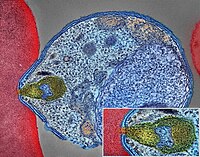
Photo from wikipedia
Abstract Urban rodents are associated with parasites and pathogens, which present health risks for humans, but information on factors related to parasite and pathogen infection in rodents in cities of… Click to show full abstract
Abstract Urban rodents are associated with parasites and pathogens, which present health risks for humans, but information on factors related to parasite and pathogen infection in rodents in cities of Latin America is scarce. This study analyzes the hosts, host community structure and environmental characteristics of parasite and pathogen fauna present in the three species of urban rodents in an urban area of South America. Rodents were captured seasonally in seven different neighborhoods. Digestive tracts were dissected under stereoscopic microscopy and feces were processed using a sedimentation technique. Protozoa and bacteria were detected through polymerase chain reaction and indirect immunofluorescence techniques. In Rattus norvegicus, Rattus rattus and Mus musculus, ten helminths, three protozoa and two bacteria were found. Six were zoonotic: Toxoplasma gondii; Hymenolepis diminuta; Rodentolepis nana; Strobilocercus fasciolaris; Leptospira borgpetersenii; and Leptospira interrogans. The parasite and pathogen infections were influenced by the host species, the host community structure, the season, and the presence of streams in the neighborhood. Urban rodents may be the infection source of many zoonotic diseases and it is important to generate public policies for this problem. This study is one example of the situation of many cities of Latin America, where peripheral neighborhoods are growing dramatically.
Journal Title: Journal of Helminthology
Year Published: 2021
Link to full text (if available)
Share on Social Media: Sign Up to like & get
recommendations!